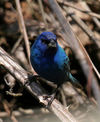Genus Passerina

Lazuli bunting - The male is easily recognized by its bright blue head and back , its conspicuous white wingbars, and its light rusty breast and white belly. The color pattern may suggest the Eastern and Western Bluebirds, but the smaller size , wingbars, and short and conical bunting bill quickly distinguish it. The female is brown, grayer above and warmer underneath, told from the female Indigo Bunting by two thin and pale wingbars and other plumage details.
Blue Grosbeak - The Blue Grosbeak is a migratory bird, with nesting grounds across most of the southern half of the United States and much of northern Mexico. It eats mostly insects, but it will also eat snails, spiders, seeds, grains, and wild fruits. The Blue Grosbeak forages on the ground and in shrubs and trees.
Painted Bunting - The Painted Bunting was one of the many species originally described by Linnaeus in his eighteenth century work Systema Naturae.
Indigo Bunting - The Indigo Bunting, Passerina cyanea, is a small seed-eating bird in the family Cardinalidae. It is migratory, ranging from southern Canada to northern Florida during the breeding season, and from southern Florida to northern South America during the winter. The Indigo Bunting is closely related to the Lazuli Bunting, and will interbreed with the latter species where their ranges overlap.
Orange-breasted Bunting - The Orange-breasted Bunting is a species of bird in the Cardinalidae family. It is endemic to Mexico. Its natural habitats are subtropical or tropical dry forests and subtropical or tropical dry shrubland.
Rose-bellied Bunting - The Rose-bellied Bunting is a species of bird in the Cardinalidae family. It is also known as Rosita's Bunting. It is endemic to a tiny strip of hills along the Pacific slope of the Isthmus of Tehuantepec in the Mexican states of Oaxaca and Chiapas, where it occurs in arid to semiarid thornforest and gallery woodlands. It is threatened by habitat loss.
Varied bunting - The range of the Varied Bunting stretches from the southern parts of Arizona, New Mexico, and Texas in the United States south throughout Mexico as far as Oaxaca. Small disjunct populations occur in the state of Chiapas in Mexico and southeastern Guatemala.







